< Back to Dao Arts Centre Bali
Bridging Ancient Daoist Wisdom and Modern Neuroscience in the Quest for Focus and Calm
In a world of constant notifications, overflowing schedules, and relentless pressure to multitask, the symptoms of Attention-Deficit/Hyperactivity Disorder (ADHD) are amplified. Characterized by restlessness, distractibility, and difficulty regulating impulses, ADHD can often feel like being caught in a storm of the mind. Modern medicine typically turns to medication and cognitive strategies, which can be highly supportive, yet more and more people are also seeking complementary practices that bring balance to body, mind, and spirit.
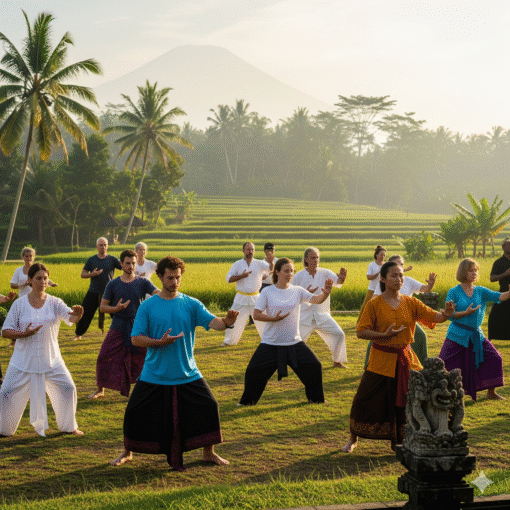
This is where Daoist practices like Qi Gong and Tai Chi enter. Rooted in thousands of years of observation of nature, energy, and the flow of life (Dao), these arts offer not only physical exercise but also a way of harmonizing attention, calming the nervous system, and cultivating presence.
In the modern world, attention is constantly pulled in a thousand directions. For those living with ADHD, this challenge is even more intense—the mind races ahead, the body struggles to stay still, impulses spark like sudden storms. Western medicine often describes this in terms of neurotransmitters and executive function. Daoist tradition, with its timeless language of Qi and Shen, sees it as energy flowing outward too quickly, spirit unanchored from its center.
Science Speaks: Focus Through Flow
The Scientific Lens – How the Practice Rewires the Brain and Body
Modern studies increasingly affirm what Daoist sages long intuited: mindful movement can calm the restless heart and sharpen the wandering mind.
Neuroregulation through movement
- Regulation of the Prefrontal Cortex (PFC): The PFC is the brain’s “executive center,” responsible for focus, impulse control, and emotional regulation. In many with ADHD, this region shows lower activity. Neuroimaging studies have demonstrated that regular practice of Tai Chi and Qi Gong increases gray matter density and enhances neural activity in the Prefrontal Cortex, effectively strengthening the brain’s “focus muscle.”
- Enhanced Neurotransmitter Function: Practices like Tai Chi have been shown to boost levels of key neurotransmitters.
- Dopamine: The “reward and motivation” chemical, often dysregulated in ADHD. Movement, especially mindful, rewarding movement, can naturally elevate dopamine levels, improving motivation and focus.
- Norepinephrine: Affects attention and response.
- Serotonin: Regulates mood and emotional well-being.
- ADHD is linked with irregularities in dopamine and norepinephrine pathways, which affect motivation and attention. Slow, repetitive, mindful movements of Tai Chi and Qi Gong have been shown to activate brain regions responsible for attention and self-regulation.
- Clinical studies with children and adolescents show improvements in attention span, mood regulation, and reduced hyperactivity after regular Tai Chi/Qi Gong sessions.
Calming the nervous system
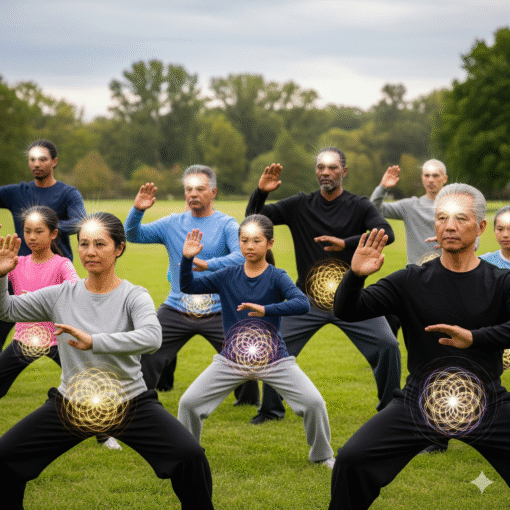
Taming the Autonomic Nervous System: ADHD is often accompanied by heightened stress and reactivity. These practices are potent regulators of the autonomic nervous system. The slow, diaphragmatic breathing (Belly Breathing) activates the parasympathetic nervous system (“rest-and-digest”), lowering cortisol levels, slowing the heart rate, and reducing the “fight-or-flight” response. This creates a physiological state of calm that is the antithesis of hyperarousal.
ADHD often correlates with an overactive sympathetic nervous system (fight-or-flight response). The deep breathing and gentle flow of Daoist practices stimulate the parasympathetic nervous system, allowing the body to shift into a calmer, more grounded state.
Embodiment as focus training
- Scientific studies on mindfulness highlight that focusing attention on bodily sensations (breath, movement, posture) strengthens neural networks of sustained attention. Qi Gong and Tai Chi are essentially moving mindfulness practices, giving ADHD minds a structured but flowing anchor.
- Improving Interoception and Body Awareness: Many with ADHD struggle with interoception—the sense of what’s happening inside their bodies. This can lead to missed cues for hunger, thirst, or emotional overwhelm. The continuous, mindful attention to posture, breath, and subtle weight shifts in Tai Chi and Qi Gong is a masterclass in interoceptive training. This helps individuals better recognize their internal states before they become overwhelming.
The Daoist Perspective: Returning to the Way
In Daoist philosophy, health and vitality arise when Qi—the vital energy—flows freely, harmonizing body, mind, and spirit with the rhythms of nature. From this perspective, ADHD is not a “disorder” but rather a particular imbalance in the flow of Qi.
To a Daoist eye, ADHD does not mean “brokenness.” It is simply a pattern—Qi scattering like wind through branches, Shen darting like a bird without perch. The practices of Qi Gong and Tai Chi are designed specifically to anchor awareness.
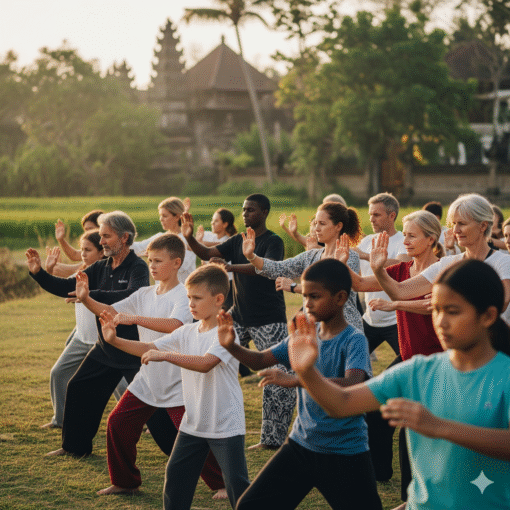
Guiding Restless Qi: In Daoist terms, hyperactivity can be seen as Qi dispersing outward too quickly, like a river overflowing its banks. Breath guides Qi back to the dantian, the center of vitality.
Regulating Scattered Shen (Spirit): The racing thoughts, distractibility, and mental chatter of ADHD can be viewed as a “scattered Shen”. Difficulty focusing relates to the Shen (spirit/mind) not being rooted in the body, floating without grounding. Spirit (Shen) settles, anchored gently by body and breath. The foundational practice of focusing on the breath and slow, intentional movement helps to gather scattered energy and direct it purposefully. This isn’t about suppressing energy but about regulating it. The hyperactive urge is channeled into precise, controlled motion. Movement harmonizes scattered energy into rhythm and flow.
The Principle of Wu Wei (Effortless Action): This central Daoist concept teaches us to act in alignment with the natural flow of life, not against it. For someone with ADHD, who often feels they are forcing themselves to focus against their own brain’s current, Wu Wei offers a different path. It’s about finding a rhythm and a practice where focus emerges naturally from the movement itself, reducing the internal struggle and resistance that leads to anxiety and exhaustion.
Daoist practices such as Qi Gong and Tai Chi work gently to bring Qi back to its center, to anchor Shen into the heart, and to create harmony between inner and outer life. Instead of fighting against restlessness, these arts channel it into flow, rhythm, and breath, transforming scattered energy into presence. Where medicine speaks of regulating dopamine, Daoism speaks of restoring harmony. Both point toward balance.
In essence, the spiritual goal is not to “cure” ADHD but to integrate its energy into a more harmonious whole, transforming a perceived weakness into a source of mindful power.
Where Science and Spirit Meet
From the scientific view, these practices regulate neurotransmitters, strengthen neural circuits of attention, and calm the nervous system. From the Daoist view, they return Qi to its natural flow and anchor the spirit. Both perspectives agree: regular practice cultivates focus, balance, and harmony.
- “Focusing Qi” becomes “Activating the PFC.” The intent to gather and direct energy has the tangible effect of increasing blood flow and neural activity in the brain’s executive control regions.
- “Calming the Shen” becomes “Regulating the Nervous System.” The quest for a tranquil spirit directly triggers a parasympathetic response, lowering stress hormones and creating a feeling of safety and calm.
- “Following the Dao” becomes “Practicing Mindfulness.” The principle of moving with natural flow is a practical exercise in present-moment awareness—the core of mindfulness, which is a gold-standard therapeutic technique for ADHD.
- Mindful movement reduces hyperactivity.
- Focus on breath and body improves attention.
- Regular practice stabilizes mood and builds inner steadiness.
What makes Daoist arts particularly suited for ADHD is their combination of movement and stillness. Mindful movement reduces hyperactivity. Focus on breath and body improves attention. Regular practice stabilizes mood and builds inner steadiness.
For the restless child or the distracted adult, sitting in still meditation can feel impossible. Daoist arts offer a bridge: movement that becomes stillness, restlessness transformed into flowing presence. Unlike seated meditation, which can be challenging for restless minds, Qi Gong and Tai Chi offer an embodied, flowing entry point into mindfulness. For many with ADHD, this is the bridge that makes inner calm accessible.
A Gentle Path Forward
ADHD may feel like living in a whirlwind. Daoist practices remind us that within every storm, there is a center, and within restlessness, there is energy waiting to be shaped. The Daoist way is not to suppress energy, but to redirect it into creativity and harmony. Each slow step, each breath, each circular movement becomes a way of gathering scattered fragments of attention into wholeness. Science sees neurons firing in new patterns; Daoism sees the dance of Yin and Yang returning to balance.
Tai Chi and Qi Gong will not replace traditional ADHD treatments, but they represent a powerful complementary tool. They offer a unique combination of benefits that few other activities can: simultaneous physical exercise, meditation, and neurological training.
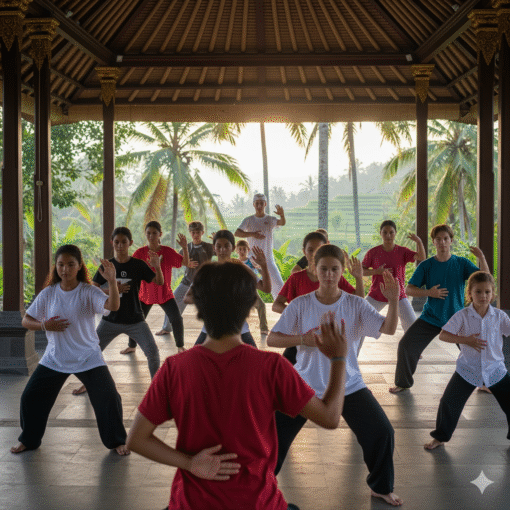
Whether understood through the lens of neurotransmitters or the movement of Qi, the value of Qi Gong and Tai Chi lies in their ability to help us return—to our breath, our body, our spirit, and the Dao. And perhaps the most profound truth is this: healing does not always come from fighting symptoms, but from embracing need for change and discovering creative flow. Daoist practices are accessible, low-impact, have no side effects, and can be practiced anywhere. For the individual with ADHD, these practices offer more than just symptom management; they offer a path to self-understanding. They teach that the goal isn’t to eliminate one’s innate energy but to learn its rhythms, to channel its flow, and to find a profound, moving stillness within.
In the graceful, flowing forms of these ancient arts, the modern mind—so often scattered and sped-up—can find a much-needed anchor, discovering that the path to focus isn’t always about trying harder, but about moving differently.
As Daoist teachers say: “The Dao is not somewhere far away. It begins with this breath, this step, this movement.”
P.S. Bridging Science and Spirit
| Scientific Insight | Daoist Interpretation |
|---|---|
| Improved attention, reduced hyperactivity, enhanced executive function | Returning Qi to center, grounding Shen in calm flow |
| Neurocognitive benefits, reduced reaction time variability | Mindfully embodying intention in each movement |
| Therapist-monitored movement yielding improved motor and behavioral control | Cultivation of inner harmony through intentional physical presence |
Scientific Evidence: What Research Shows
Tai Chi for Adolescents
An adolescent group (aged mid-teens) practicing Tai Chi twice weekly for five weeks demonstrated significant reductions in:
- Anxiety
- Daydreaming
- Inappropriate emotional responses
- Hyperactivity
A follow-up two weeks later confirmed the persistence of these benefits.
PMC
Kennedy Krieger Institute study: Tai Chi–based mindful movement for school-age children led to better regulation of attention, hyperactivity, and impulsivity, and improvements in motor control—suggesting that motor capabilities may serve as an indicator of positive outcomes.
kennedykrieger.org
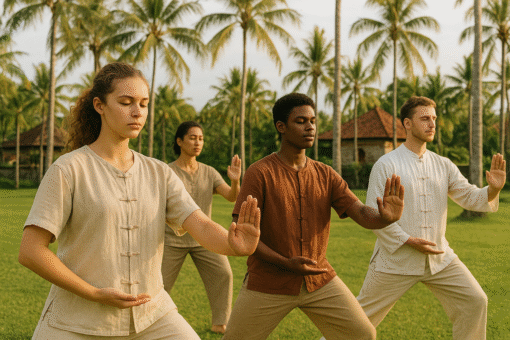
Article Author
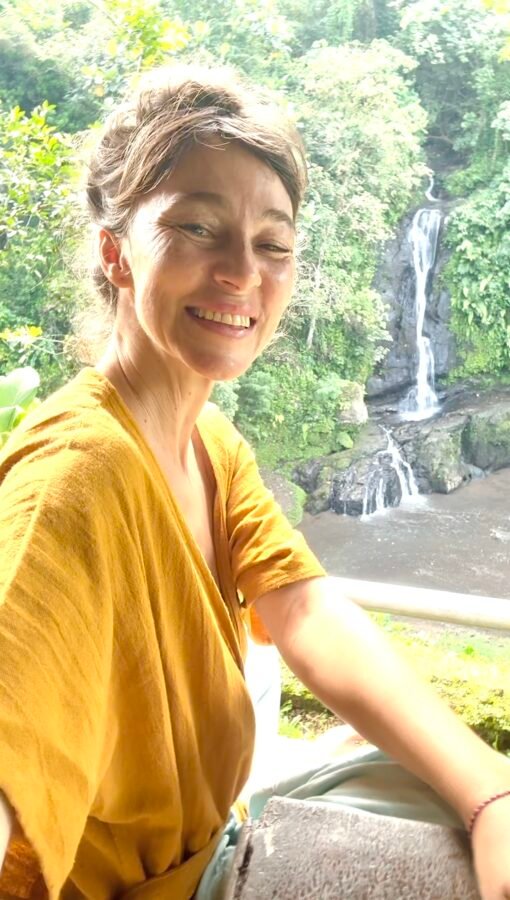
Lola Lhamo ~ Bridging Ancient Wisdom and Modern Science
Lola Lhamo is a Daoist Medicine practitioner, energy healer, teacher, and the visionary behind QUANTA Energetics & Leadership. She expertly bridges ancient spiritual practices with cutting-edge science, exploring the profound connection between the two and applicable way of integrating this wisdom for Architects of New Earth.
Deeply rooted in Daoism, Buddhism, and Yoga, Lola dedicates her life to uncovering the healing power of energy and heart-mind. Her extensive expertise covers movement arts (Yoga, Qi Gong, Tai Chi, Wudang Sword), energy medicine (Daoist Medicine, Acupuncture, Reiki, Sound Energy Medicine), and the transformative depths of Daoist Alchemy and Himalayan Mysticism, trained by revered masters like Grandmaster Mantak Chia, Li Shifu (Wudang Five Immortals Temple, The Dragon Gates, Pure Yang), Yogi Ashokananda (Himalayan Yoga), and Tibetan Nyingma & Bon lamas.
Lola is a holder of the Daoist Dragon Gates (31st generation), Pure Yang (24th generation), Medicine King (30th generation) lineages. She also helped building Buddhist Stupa of Enlightenment at the Roerich Museum.
Through her pioneering initiatives like Daoist Arts Centre, QUANTA Bio-Energy Centre, SoundEnergyMedicine.com, and Creators.Earth, Lola creates powerful bridges. She seamlessly integrates Daoist Arts with Neuroscience, Sound Therapy with Frequency Medicine, Meditation with Brainwave Optimization. Drawing on over 15 years in international strategy consultancy spearheading innovative turnarounds, this unique holistic approach forms the core of her global empowerment QUANTA Energetics & Leadership for Architects of New Earth. empowering individuals to harness both spiritual wisdom and scientific insight, building a living platform for vitality, clarity, wholeness, and collective well-being.
Sources:
- PubMedThe Effect of Meditation-Based Mind-Body Interventions on Symptoms and Executive Function in People With ADHD: A Meta-Analysis of Randomized Controlled Trials – PubMed
- Tech ScienceIJMHP | Mind-Body Exercises (Yoga/Tai Chi) for Attention-Deficit/Hyperactivity Disorder: A Quantitative Evidence of Experimental Studies
- PubMedTai chi training reduces self-report of inattention in healthy young adults
- PMCTai chi training reduces self-report of inattention in healthy young adults – PMC
- PMCMind–Body Therapy for Children with Attention-Deficit/Hyperactivity Disorder – PMC
- PubMedEffects of taijiquan and qigong practice over behavioural disorders in school-age children: A pilot study – PubMed
- PubMedEffects of Qigong vs. routine physical exercise in school-aged children with attention-deficit hyperactivity disorder: a randomized controlled trial – PubMed
- kennedykrieger.orgStudy Discovers Children with ADHD Showed Reduction in Core ADHD Symptoms Following Eight-Week Tai-Chi Based Mindfulness Training | Kennedy Krieger Institute
- WikipediaManagement of attention deficit hyperactivity disorderAugust 14, 2025
- nih.govTai Chi Chuan evidence related to impulsivity and impulse related disorders: A scoping review – PubMedSkip to main page content Save Email Send to Display options Full text links Cite Display options ABSTRACT Background: The purpose of this study was to review the evidence for the potential of…
- nih.gov“Tai Chi Training for Attention Deficit Hyperactivity Disorder: A Feasibility Trial in College Students” – PMCSkip to main content NewTry this search in PMC Beta Search Complement Ther Med . Author manuscript; available in PMC: 2021 Sep 1. Published in final edited form as: Complement Ther Med. 2020 Aug 1…
- springer.comEffects of Tai Chi and Qigong in Children and Adolescents: A Systematic Review of Trials | Adolescent Research ReviewTable 1 Study descriptions of Tai Chi and Qigong interventions for children and adolescents Target sample populations were varied, with three studies were targeting the general student body (Bao and…
- cdsu.edu.cnEffects of Tai Chi Exercise on Attention Deficit Hyperactivity Disorder Tendency in ChildrenJournal of Chengdu Sport University ›› 2016, Vol. 42 ›› Issue (5): 29-32.doi:
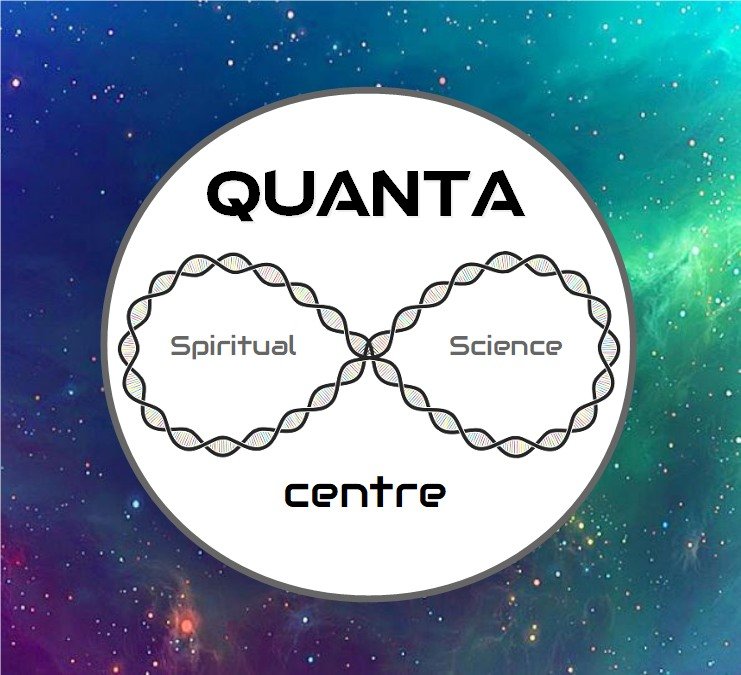
Leave a Reply